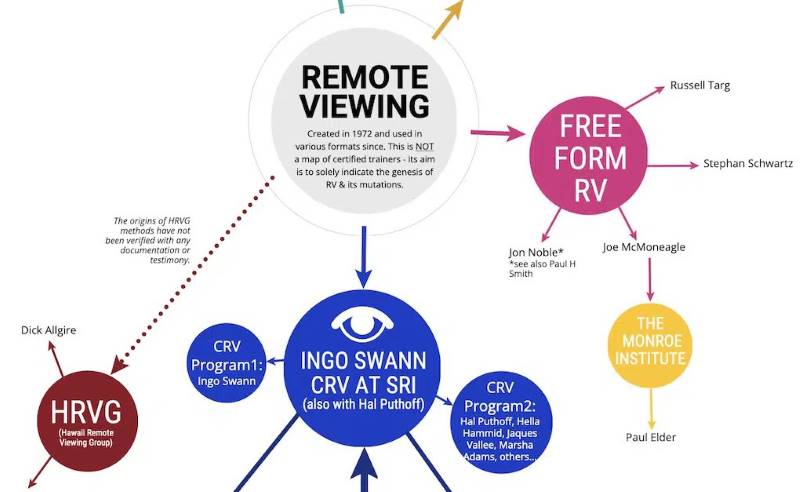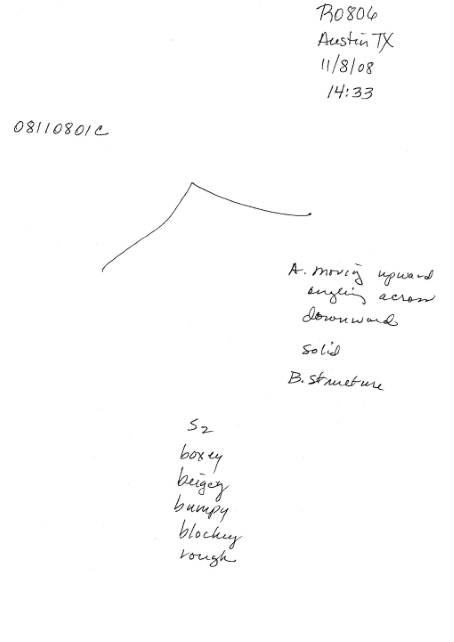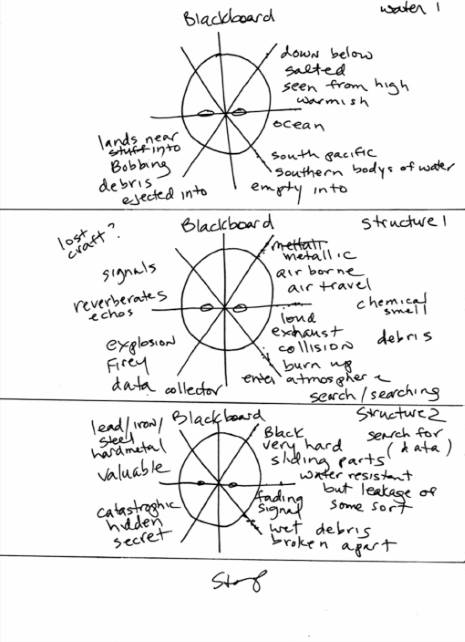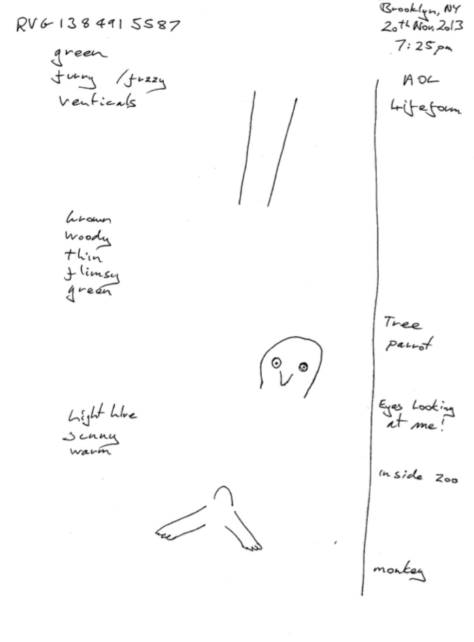遠隔視の階梯
前置き
別記事で遠隔視の階梯について話題にしたので、その説明を含む Web 記事を和訳しておく。
- 第1段階。サイトまたはターゲットの基本的で全体的な性質の認識(通常「主要な ゲシュタルト」と呼ばれる)。主なゲシュタルトの例としては、「土地」、「構造物」、「水」、「出来事」などが挙げられる。
- 第2段階。基本的な感覚-味、音、色、光の質、質感、温度など。
- 第3段階。敷地やターゲットの次元的特質の知覚-すなわち、高さ、幅、奥行き、 角度、曲率、密度など。見る人の知覚をスケッチすることは、このステージの重要な側面である。
- 第4段階 現場やターゲットに関する、ますます複雑で抽象的な知覚。
- 第5段階。信号線の 「尋問」。ターゲットの細部をより完全に探索できるようにする。
- 第6段階。さらなる質的情報�を得ながら、現場やターゲットの側面をさらにスケッチしたり、三次元モデル化したり、彫刻化したりする。
出典
Remote Viewing Methodologies | IRVA https://www.irva.org/remote-viewing/methodology
https://www.remoteviewed.com/remote-viewing-methods-map/
なお、出典元のサイト(IRVA)によると IRVA とは以下のような組織。
国際リモートビューイング協会(IRVA)は、1999年3月18日、ニューメキシコ州アラモゴードで開催されたリモートビューイングに関する初の専門家会議に合わせて、選ばれた科学者と実践者によって組織された。 その目的は、「リモート・ビューイング」という学問を評価する仕組みを提供し、科学的に健全な研究を奨励し、倫理基準を提案し、リモート・ビューイング・コミュニティと一般大衆に概要の教育情報を提供する組織を設立することであった。 IRVAの主な目的は、リモートビューイングに関する情報、トレーニング、研究、教育に関して、公平なアプローチを提供することです。 IRVAの主要な任務のひとつは、信頼できる、責任あるリモートビューイングに焦点を当てたインターネットサイトを維持することです:
和訳:DeepL(2024-07 model)
モート・ビューイングの方法論

モート・ビューイングの方法論マップ
Daz Smith (from remotedviewed.com)は、方法論とそれに関連する主要な名称がどのように関連しているかを図にまとめた。
この地図は、初期のスタンフォード研究所(SRI)の時代から、「スター・ゲート」プログラムの公開後の実践者の急増に至るまでのリモート・ビューイングの歴史的見解としても見ることができます。
IRVAは、この地図に描かれている名称や方法論、あるいは以下に説明する方法論を推奨するものではない。
コントロールされたリモート・ビューイング

コントロールド・リモート・ビューイングまたはコーディネートド・リモート・ビューイング(CRV)は、その派生技術も含めて、リモート�・ビューイングの方法論の中で最も広く知られ、実践されているものであろう。CRVはもともと「座標」リモート・ビューイングとして知られていたが、それは視聴者をターゲットにする主なメカニズムがターゲットの位置の地理的座標だったからである。1995年に政府のプログラムが公に知られるようになった後、手法の広範な側面を反映するために、名称が「座標」から「制御された」に変更された。CRVは70年代半ばから後半にかけて開発された。SRIの研究によってリモート・ビューイングの有望な側面が明らかになるにつれ、一部の人々が生得的に持っていると思われるスキルを、まだその能力を発揮していない他の人々に開発する方法を探ることが合理的であると思われた。ハル・プトフとインゴ・スワンは緊密に協力し、リモート・ビューイングの構造化されたアプローチを開発した。この方法は、軍人と政府の民間人が効果的なリモート・ビューワーになるための訓練に使われ、政府プログラムの最後の11年間に採用された主要なRV手法となった。
CRVは、誰かを「サイキック」にするために訓練するのではなく、スワンが言うように、自分の知覚の「パラメータを広げる」ために教えるという考え方に基づいている。CRVによって得られた情報は、理論化された「信号線」に乗って視聴者に伝わり、視聴者の潜在意識がそれを感知する。CRVの目的は、視聴者の潜在意識から意識の閾値を越えて覚醒意識へと情報が伝達されるのを促進することである。視聴者は、リモート・ビューイング・セッションの過程で遭遇する精神的な「ノイズ」に対処する方法、言い換えれば、コントロールする方法を訓練される��。
このプロセスを実施するために、CRVは、視聴者がRV信号線とより深く接触するにつれて、徐々に深くなる意識のレベルに対応する一連の正式な段階として構成されている。これらの段階の典型的な説明は以下の通りである:
- 第1段階。サイトまたはターゲットの基本的で全体的な性質の認識(通常「主要な ゲシュタルト」と呼ばれる)。主なゲシュタルトの例としては、「土地」、「構造物」、「水」、「出来事」などが挙げられる。
- 第2段階。基本的な感覚-味、音、色、光の質、質感、温度など。
- 第3段階。敷地やターゲットの次元的特質の知覚-すなわち、高さ、幅、奥行き、 角度、曲率、密度など。見る人の知覚をスケッチすることは、このステージの重要な側面である。
- 第4段階 現場やターゲットに関する、ますます複雑で抽象的な知覚。
- 第5段階。信号線の 「尋問」。ターゲットの細部をより完全に探索できるようにする。
- 第6段階。さらなる質的情報を得ながら、現場やターゲットの側面をさらにスケッチしたり、三次元モデル化したり、彫刻化したりする。
テクニカル・リモート・ビューイング(TRV)やサイエンティフィック・リモート・ビューイング(SRV)のような、オリジナルのスワン/プットオフの方法論のさまざまな派生版は、いくつかの段階の順序を入れ替えたり、内容の一部を変更したり、SRIがもともと採用していた語彙に変更を加えたりしている。しかし、これらの派生物の全体的な意図は、CRVのオリジナル版と変わりません。
拡張リモート・ビューイング

エクステンデッド・リモート・ビューイング(Extended Remote Viewing)、略してERVでは、視聴者はベッドやその他の快適な支持体の上でリラックスし、「ヒプナゴギー」状態(睡眠と覚醒の境目の状態)になろうとする。部屋は暗くし、可能であれば防音もする。
鑑賞者が意識の端に達すると、部屋にいる2人目の人間、モニターが、鑑賞者が希望するターゲットにアクセスするための指示であるタスキングでセッションを開始する。鑑賞者が正しいターゲットの要素を説明できるようになると、モニターは静かにターゲットについて質問を投げかける。これらの質問は、詳細、目的、外観、構造、活動、または他のターゲットに関連する情報を要求することができる。モニターは、視聴者の答えを記録したり、書き留めたりする。セッションの後、視聴者は知覚されたものについて、適切なスケッチや図面とともにさらにメモをとる。
ERVの背後にある理論は、リモート・ビューイングの印象が潜在意識から湧き上がってくる可能性を考えると、意図的に無意識の状態に近づくことで、より少ないメンタルノイズでこれらの印象を検出しやすくなるはずだというものである。(現実には、このノイズはERVでは他のリモート・ビューイングの方法よりも少ないようには見えない)。
ERVという用語は、もともとF・ホームズ 「スキップ 」アトウォーター大尉が、メリーランド州フォート・ミードにある 陸軍のリモート・ビューイング部隊の作戦・訓練担当官をしていたときに作ったものである。ERVはその名称が使われる以前から存在し、最初の軍用視聴者の何人かが使用していた。 ERVのセッションはCRVのセッションよりも時間がかかったため、スキップはそれを 「拡張 」RVと呼ぶことにし、その名前が定着した。彼はその後、モンロー研究所でHemi-Sync™技術の開発研究を指揮するようになりました。これは、ヘッドフォンを通して視聴者に同期したトーンを適用することにより、ERVを増強する方法です。
HRVG の方法論

ハワイ・リモート・ビューイング・ギルド(HRVG)の方法論は、CRVやERVの実践者にも馴染み深い側面を持っており、HRVG会長のグレン・ウィートンは、1980年代に米陸軍特殊部隊と有名なサイキック、リチャード・アイルランド博士との間で行われた共同研究であると説明している。
この方法論は、神経言語プログラミング(NLP)と米陸軍の諜報活動「SALUTE」(規模、活動、場所、 単位、時間、装備、備考)の報告形式を統合したものである。高度に構造化されている一方で、この方法論は、遠隔視聴者が警戒心の強い精神的ベータ波収集状態から、よりリラックスした体験的シータ波拡張遠隔視聴(ERV)状態へと移行できる多目的なプラットフォームを提供しま��す。
視聴者は、潜在意識に働きかけ、「黒板 」と呼ばれる想定領域にターゲットイメージを視覚として配置するよう訓練する。視聴者はまた、潜在意識とのコミュニケーションを促進するNLPのテクニックを使いながら、他の感覚的、運動学的なデータも順次入手する。
視聴者は警戒心の強いベータ波状態でセッションを開始し、テンポの速い、高度に構造化された方法論に取り組む。S-1の視覚的イデオグラムでターゲットの主要なジェスチャーを知覚・識別し、NLPテクニックを使ってS-2の感覚データの収集に移り、S-3のデータ統合またはサイトスケッチにデータを組み立てる。セッションが続き、ターゲットとの接触が増えるにつれて、視聴者は自然にアルファ波状態に移行し、S-4の情報カスケードと 「黒板 」の使用に移る。アルファ状態で許される長い滞留時間により、視聴者は各ゲシュタルトをより深く明瞭に調べる。S-5では、視聴者はペンと紙を脇に置き、クールダウンのテクニックを行い、よりシータ脳波の状態に到達し、モニターされたERVに入る。
この方法論には、分析的な親しみやすさを保ちながら、視覚データの取得を助長する収集と報告のスキームが含まれている。この方法論には、場所やタイムラインを決定するための時間的モデルも含まれている。また、視聴者は、リモート視聴の結果を評価するために使用する3段階の分析アプリーケを学ぶ。
Targ/Schwartz 流の自然的遠隔視

より構造化された方法論が開発される以前は、リモート・ビューワーは、しばしば自分自身のサイキック能力との取り組み方に基づいて、より自由なスタイルの方法を使用していた。
このような自由なスタイルの方法は、SRIの初期の頃、そして政府出資のプログラム全体を通じて、また米軍やステファン・シュワルツのメビウス・グループでも運用されていた。これらのアプローチは、リモート・ビューイングの初期の成功を生み出し、SRIとPEAR研究所で行われた多くの研究の基礎となった。今日でも、エド・メイの基礎研究所(LFR)でその利用が続けられている。
視聴者は、セッションを記録する独自の方法や形式を自由に使用することができますが、次のことを取り入れるべきです:自由な回答を可能にするオープンな質問、スケッチ、すべての感覚の問い合わせ、そして重要なことは、心霊的知覚であると考えられる回答と分析や推測であると考えられる回答を分けて、識別ではなく対象の説明に焦点を当てることです。このような個人的なアプローチは、リモート・ビューイングのプロトコルが満たされている限り、「リモート・ビューイング」と呼ぶことができる。
ジョー・マクモニーグル、ラッセル・ターグ、ステファン・シュワルツは、それぞれの著書の中で、このようなリモート・ビューイングのスタイルと、それが使われたプロジェクトについて述べている。シュワルツとマクモニーグルは今日でもこの方法を教え続けている。
夢の遠隔視

予知的な情報やアイデア、創造的なひらめきが夢からもたらされたという報告はよくある。夢を見ている状態や、眠っている状態と目覚めている状態の間の閾値は、分析的プロセスが抑制される自然な時間であり、創造的で予知的な印象が花開くための、より受容的な環境を提供する。
目標の夢を見るには、その意図をしっかりと確立する必要がある。目標の番号(あるいは「明日の一面のメイン写真」など、目標が指定されている方法)を書き留め、日中に何度か自分に言い聞かせるのが効果的だ。そうすることで、その夢を見るつもりであることを意識に知らせることができる。ベッドに入ったら、眠りにつくまでその目標に集中する。
夢の印象、イメージ、感覚は、目覚めたときに直接記録する必要がある。目覚めたときに少しでも動き回ると、夢の記憶が消えてしまうので、夢を記録するのに必要な資料を枕元に用意して、手近に置いておくようにする。目覚めたときに夢を記録する習慣は、夢の記憶に役立つ。
連想的遠隔視

アソシエイティヴ・リモート・ビューイング(ARV)は手法ではなく、スポーツ競技(勝つか、負けるか、引き分けるか)や金融市場(少し上がるか、大きく上がるか、少し下がるか、大きく下がるか)のように、起こりうる結果がわかっている状況で、将来の出来事の結果を予測するために使われるリモート・ビューイングの応用である。
例えば、来週の株価について2つの結果をテストする場合、株価が上がるか下がるか、それぞれの結果を表す写真が1枚ずつ必要である。一般的には写真が使われるが、物を使うこともできる。イベント発生前に、視聴者は将来(イベント発生後)に表示される写真を説明することになる。
分析者/判定者は、遠隔視聴者のセッションを利用して、以前に選択され、潜在的な結果に関連付けられた写真との比較に基づいて予測を行うことができる。視聴者のセッションが最もよく似ている画像に関連する結果が予測である。
フィードバック(実際の結果に関連付けられている画像)は、イベントの後にのみ視聴者に表示することができます。
原文
▼原文展開
Remote Viewing Methodologies
11–13 minutes
A Map of Remote Viewing Methodologies
pic
Daz Smith (from remotedviewed.com) has put together a diagram of how the methodologies and key names associated with them are related.
The map can also be viewed as a historical view of remote viewing from the early Stanford Research Institute (SRI) period to the proliferation of practitioners after the disclosure of the ‘Star Gate’ program.
IRVA does not endorse any of the names or methodologies depicted on the map or described below.
ref: https://www.remoteviewed.com/remote-viewing-methods-map/
Controlled Remote Viewing
pic
Controlled Remote Viewing or Coordinate Remote Viewing (CRV)–together with its derivatives–is probably the most widely known and practiced of the varieties of remote viewing methodologies. CRV was originally known as “coordinate” remote viewing, because the primary mechanism for targeting viewers was the geographic coordinates of the target’s location. After the government program became public knowledge in 1995, the name was changed from “coordinate” to “controlled” to reflect the broader aspects of the methodology. CRV was developed beginning in the mid-to-late 70s. As SRI’s research revealed the promising aspects of remote viewing, it seemed reasonable to explore ways to develop the skill that some people seemed innately to have in others who had not yet demonstrated the ability. Working closely together, Hal Puthoff and Ingo Swann worked out a structured approach to remote viewing that promised to make the skill transferable and teachable. This method was used to train military personnel and government civilians to become effective remote viewers, and became a major RV methodology employed for the last 11 years of the government program.
CRV is based on the notion that one does not train someone to be “psychic,” but rather teaches a person to “expand the parameters” of his or her perceptions, as Swann puts it. Information obtained through CRV is carried to the viewer on a theorized “signal line” which the viewer’s subconscious detects. The goal of CRV is to facilitate the transfer of information from the viewer’s subconscious, across the threshold of awareness, and into waking consciousness, where it can be “decoded” into a form the viewer can express intelligibly. Viewers are trained how to deal with–in other words, control–the mental “noise” encountered in the course of the remote viewing session.
To implement this process, CRV is structured as a set of formal stages which correspond to the progressively deeper levels of awareness the viewer goes through as he or she gains ever greater contact with the RV signal line. A typical description of these stages is as follows:
- Stage 1. Perception of basic, overall nature of the site or target (usually referred to as the “major gestalt”). Examples of these major gestalts might be “land,” “structure,” “water,” “event,” etc.
- Stage 2. Basic sensory perceptions–tastes, sounds, colors, qualities of light, textures, temperatures, etc.
- Stage 3. Perception of the site’s or target’s dimensional qualities–i.e., height, breadth, width, depth, angularity, curvature, density, etc. Sketching of viewer perceptions is an important aspect of this stage.
- Stage 4. Perception of increasingly complex and abstract perceptions about the site or target.
- Stage 5. “Interrogation” of the signal line. Allows details of the target to be more fully explored.
- Stage 6. Allows further sketching and three-dimensional modeling or sculpting of aspects of the site or target, while acquiring further qualitative information.
Various derivatives of the original Swann/Puthoff methodology, such as Technical Remote Viewing (TRV) and Scientific Remote Viewing (SRV), have re-ordered some of the stages, made alterations to some of the content, and introduced changes in the vocabulary originally adopted by SRI. However, the overall intent of each of these derivatives remains the same as the original version of CRV.
Extended Remote Viewing
pic
In Extended Remote Viewing, or ERV for short, a viewer relaxes on a bed or other comfortable support and tries to reach a ‘hypnagogic’ state – a condition at the borderline between asleep and awake. The room is darkened and soundproofed if possible.
As the viewer reaches the edge of consciousness, a second person in the room, the monitor, begins the session with a tasking, that is directions to the viewer to access the desired target. Once the viewer can describe elements of the correct target, the monitor quietly poses questions about the target. These questions may request details, purpose, appearance, construction, activities, or other target-related information. The monitor records or writes down the answers the viewer provides. After the session the viewer makes additional notes about what was perceived, along with appropriate sketches or drawings.
The theory behind ERV is that, given the likelihood that remote viewing impressions bubble up from the subconscious,then deliberately approaching an unconscious state should make it easier to detect these impressions with less mentalnoise. (In reality, this noise does not seem any less in ERV than it does in other remote viewing methods.)
The term ERV was originally coined by Capt. F. Holmes “Skip” Atwater while he was operations and training officer for the Army’s remote viewing unit at Ft. Meade, MD. ERV existed before its name did, and was used by some of the first military viewers. Because an ERV session took longer than did a CRV one, Skip decided to call it “extended” RV, and the name stuck. He later went on to direct research at the Monroe Institute in the development of Hemi-Sync™ technology; a way of augmenting ERV through the application of synchronized tones administered to the viewer through headphones.
HRVG Methodology
pic
With aspects familiar to CRV and ERV practitioners alike, the Hawaii Remote Viewers’ Guild (HRVG) methodology is described by HRVG President, Glenn Wheaton, as a 1980’s collaboration between the US Army Special Forces and famed psychic Dr. Richard Ireland.
The methodology is an integration of Neuro-linguistic Programming (NLP) and a US Army intelligence “SALUTE” (size, activity, location, unit, time, equipment, remarks) reporting format. While highly structured, the methodology provides a versatile platform from which the remote viewer can transition from an alert mental Beta wave collection state to a more relaxed experiential Theta wave extended remote viewing (ERV) state.
Viewers engage and train their subconscious to place target imagery as visuals in a notional area called “Blackboard.” Viewers also obtain other sensory and kinesthetic data in sequential order, using NLP techniques to facilitate communication with the subconscious.
The viewers begin a session in an alert Beta wave state, working the fast-paced, highly structured methodology. They perceive and identify the major gestalts at the target with an S-1 visual ideogram, move on to the collection of sensory data in S-2 using NLP techniques, and then assemble the data into an S-3 data consolidation or site sketch. As the session continues and target contact increases, viewers naturally move to an Alpha wave state for the S-4 information cascade and use of the “Blackboard.” With the longer dwell time allowed in an Alpha state, viewers examine each gestalt with more depth and clarity. By S-5 the viewers set aside pen and paper, do a cool-down technique to attain a state with more Theta brain waves, and go into monitored ERV.
The methodology includes a collection and reporting scheme that is conducive to the capture of visual data while remaining analytically friendly. The methodology includes temporal models for the determination of locations as well as timelines. Viewers are also taught three tiers of analytical appliqués for use in evaluating the results of their remote viewing efforts.
‘Targ/Schwartz’ / Natural Remote Viewing
pic
Prior to the development of more structured methodologies, the remote viewer used a more free-style method often based on their own way of working with their psychic abilities.
Such free-style methods were used exclusively in the early days at SRI, and throughout the government-funded program, as well as operationally in the United States military and at Stephan Schwartz’ Mobius group. These approaches produced remote viewing’s early successes and were the basis for much of the research performed at SRI and the PEAR laboratories. Their use continues today at Ed May’s Laboratories for Fundamental Research (LFR).
Although the viewer is free to use their own methods and format of recording the session the following should be incorporated: open questioning that allows for free-response answers, sketching, the query of all senses, and importantly, a focus on target description and not identification, with a separation between responses believed to be psychic perceptions from those believed to be analysis and conjecture. Such personal approaches can be referred to as ‘remote viewing’ as long as the remote viewing protocols are met.
Joe McMoneagle, Russell Targ and Stephan Schwartz describe this style of remote viewing and the projects it was used in within their books. Schwartz and McMoneagle continue to teach it today.
Dream Remote Viewing
pic
Reports of precognitive information, ideas and creative inspiration coming from dreams are common. The dream state and the threshold states between being asleep and awake are natural times where the analytical processes are suppressed, providing a more receptive environment for creative and precognitive impressions to flourish.
To dream about a target, you will need to firmly establish that intention; writing the target number (or however the target has been specified, for example, ‘main photograph on tomorrow’s front page’) down and saying it to yourself several times during the day will help. This will inform your consciousness that you intend to dream about it. Once in bed, focus on the target as you fall asleep.
Dream impressions, images and sensations need to be recorded directly as you awaken. Moving around to any extent when you wake up will dislodge the memories of your dream, so ensure that you have the necessary materials to record your dreams by your bedside, ready, close at hand. The habit of recording your dreams, as you awake, will help with remembering them.
Associative Remote Viewing
pic
Associative Remote Viewing (ARV) is not a method, but an application of remote viewing used to predict the outcome of future events in situations where there are known possible outcomes, such as in sports competitions (i.e., win, lose or draw) and financial markets (e.g., up a little/up a lot/down a little/down a lot).
To use ARV each potential outcome needs to be associated (hence, ‘associative remote viewing’) with its own target, for example, if two outcomes are to be tested for next week’s stock price, e.g., will the stock go up or down, then two photographs would be required – one to represent each outcome. Photographs are generally used, but objects can be used as well. Before the time of the event the viewer is tasked with describing the picture they will be shown in the future (after the event).
An analyst/judge can use the remote viewer’s session to make a prediction based on a comparison between it and the pictures previously chosen and associated with the potential outcomes. The outcome associated with the picture that the viewer’s session most closely resembles is the prediction.
The feedback (the picture associated with the actual outcome) can only be shown to the viewer after the event.
(2024-10-19)